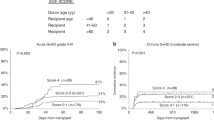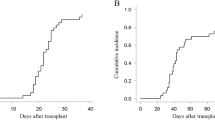Abstract
We investigated the feasibility of reduced-intensity conditioning with 4 Gy total body irradiation, fludarabine (30 mg/m2 for 6 days), and busulfan (4 mg/kg for 2 days) for bone marrow transplantation from a serologically HLA-matched unrelated donor. Seventeen adult patients (median age, 55 years; range, 27-67 years) with various hematologic malignancies (6 in remission, 11 not in remission) were treated. Successful engraftment was achieved in all patients at a median of day 18 (range, day 14-35) after transplantation, although subsequent secondary graft failure was observed in 2 patients. The cumulative incidence of acute graft-versus-host disease (GVHD) of grades II to IV at day 100 was 48%. With a median follow-up of 286 days (range, 56-687 days), the rates of 1-year overall survival, 100-day nonrelapse mortality, and 1-year nonrelapse mortality were 41%, 14%, and 46%, respectively. Eleven patients died, and the causes of death were relapse (n = 4), pulmonary complications (n = 4), acute GVHD (n = 2), and sepsis (n = 1). The remaining 6 patients (at transplantation, 2 were in remission, and 4 were not in remission) are currently still in remission. These results suggest that this regimen reduces the risk of graft failure, but further studies are needed to ameliorate transplantation-related toxicities, primarily GVHD and/or pulmonary complications. cr 2007 The Japanese Society of Hematology
Similar content being viewed by others
References
Kanda Y, Chiba S, Hirai H, et al. Allogeneic hematopoietic stem cell transplantation from family members other than HLA-identical siblings over the last decade (1991-2000).Blood. 2003;102:1541–1547.
Giralt S, Estey E, Albitar M, et al. Engraftment of allogeneic hematopoietic progenitor cells with purine analog-containing chemotherapy: harnessing graft-versus-leukemia without myeloab-lative therapy.Blood. 1997;89:4531–4536.
Khouri IF, Keating M, Korbling M, et al. Transplant-lite: induction of graft-versus-malignancy using fludarabine-based nonablative chemotherapy and allogeneic blood progenitor-cell transplantation as treatment for lymphoid malignancies.J Clin Oncol. 1998;16:2817–2824.
Slavin S, Nagler A, Naparstek E, et al. Nonmyeloablative stem cell transplantation and cell therapy as an alternative to conventional bone marrow transplantation with lethal cytoreduction for the treatment of malignant and nonmalignant hematologic diseases.Blood. 1998;91:756–763.
Childs R, Clave E, Contentin N, et al. Engraftment kinetics after nonmyeloablative allogeneic peripheral blood stem cell transplantation: full donor T-cell chimerism precedes alloimmune responses.Blood. 1999;94:3234–3241.
Bornhauser M, Thiede C, Schuler U, et al. Dose-reduced conditioning for allogeneic blood stem cell transplantation: durable engraftment without antithymocyte globulin.Bone Marrow Transplant. 2000;26:119–125.
McSweeney PA, Niederwieser D, Shizuru JA, et al. Hematopoietic cell transplantation in older patients with hematologic malignancies: replacing high-dose cytotoxic therapy with graft-versus-tumor effects.Blood. 2001;97:3390–3400.
Maris MB, Niederwieser D, Sandmaier BM, et al. HLA-matched unrelated donor hematopoietic cell transplantation after nonmyeloablative conditioning for patients with hematologic malignancies.Blood. 2003;102:2021–2030.
Bornhauser M, Thiede C, Platzbecker U, et al. Dose-reduced conditioning and allogeneic hematopoietic stem cell transplantation from unrelated donors in 42 patients.Clin Cancer Res. 2001;7:2254–2262.
Giralt S, Thall PF, Khouri I, et al. Melphalan and purine analog-containing preparative regimens: reduced-intensity conditioning for patients with hematologic malignancies undergoing allogeneic progenitor cell transplantation.Blood. 2001;97:631–637.
Nagler A, Aker M, Or R, et al. Low-intensity conditioning is sufficient to ensure engraftment in matched unrelated bone marrow transplantation.Exp Hematol. 2001;29:362–370.
Kroger N, Sayer HG, Schwerdtfeger R, et al. Unrelated stem cell transplantation in multiple myeloma after a reduced-intensity conditioning with pretransplantation antithymocyte globulin is highly effective with low transplantation-related mortality.Blood. 2002;100:3919–3924.
Bornhauser M, Storer B, Slattery JT, et al. Conditioning with flu-darabine and targeted busulfan for transplantation of allogeneic hematopoietic stem cells.Blood. 2003;102:820–826.
Niederwieser D, Maris M, Shizuru JA, et al. Low-dose total body irradiation (TBI) and fludarabine followed by hematopoietic cell transplantation (HCT) from HLA-matched or mismatched unrelated donors and postgrafting immunosuppression with cyclo-sporine and mycophenolate mofetil (MMF) can induce durable complete chimerism and sustained remissions in patients with hematological diseases.Blood. 2003;101:1620–1629.
Wong R, Giralt SA, Martin T, et al. Reduced-intensity conditioning for unrelated donor hematopoietic stem cell transplantation as treatment for myeloid malignancies in patients older than 55 years.Blood. 2003;102:3052–3059.
Rodriguez R, Parker P, Nademanee A, et al. Cyclosporine and mycophenolate mofetil prophylaxis with fludarabine and melphalan conditioning for unrelated donor transplantation: a prospective study of 22 patients with hematologic malignancies.Bone Marrow Transplant. 2004;33:1123–1129.
Inamoto Y, Oba T, Miyamura K, et al. Stable engraftment after a conditioning regimen with fludarabine and melphalan for bone marrow transplantation from an unrelated donor.Int J Hematol. 2006;83:356–362.
Sullivan KM, Agura E, Anasetti C, et al. Chronic graft-versus-host disease and other late complications of bone marrow transplantation.Semin Hematol. 1991;28:250–259.
Przepiorka D, Weisdorf D, Martin P, et al. 1994 Consensus Conference on Acute GVHD Grading.Bone Marrow Transplant. 1995;15:825–828.
Deeg HJ, Amylon ID, Harris RE, et al. Marrow transplants from unrelated donors for patients with aplastic anemia: minimum effective dose of total body irradiation.Biol Blood Marrow Transplant. 2001;7:208–215.
Bacigalupo A, Lamparelli T, Bruzzi P, et al. Antithymocyte globulin for graft-versus-host disease prophylaxis in transplants from unrelated donors: 2 randomized studies from Gruppo Italiano Trapianti Midollo Osseo (GITMO).Blood. 2001;98:2942–2947.
Hale G, Jacobs P, Wood L, et al. CD52 antibodies for prevention of graft-versus-host disease and graft rejection following transplantation of allogeneic peripheral blood stem cells.Bone Marrow Transplant. 2000;26:69–76.
Chakraverty R, Peggs K, Chopra R, et al. Limiting transplantation-related mortality following unrelated donor stem cell transplantation by using a nonmyeloablative conditioning regimen.Blood. s2002;99:1071–1078.
Ho AY, Pagliuca A, Kenyon M, et al. Reduced-intensity allogeneic hematopoietic stem cell transplantation for myelodysplastic syndrome and acute myeloid leukemia with multilineage dysplasia using fludarabine, busulphan, and alemtuzumab (FBC) conditioning.Blood. 2004;104:1616–1623.
van Besien K, Artz A, Smith S, et al. Fludarabine, melphalan, and alemtuzumab conditioning in adults with standard-risk advanced acute myeloid leukemia and myelodysplastic syndrome.J Clin Oncol. 2005; 23: 5728–5738.
Lim ZY, Ho AY, Ingram W, et al. Outcomes of alemtuzumab-based reduced intensity conditioning stem cell transplantation using unrelated donors for myelodysplastic syndromes.Br J Haematol. 2006;135:201–209.
de Lima M, Couriel D, Thall PF, et al. Once-daily intravenous busulfan and fludarabine: clinical and pharmacokinetic results of a myeloablative, reduced-toxicity conditioning regimen for allogeneic stem cell transplantation in AML and MDS.Blood. 2004;104:857–864.
Author information
Authors and Affiliations
Corresponding author
About this article
Cite this article
Onishi, Y., Mori, Si., Kusumoto, S. et al. Unrelated-Donor Bone Marrow Transplantation with a Conditioning Regimen Including Fludarabine, Busulfan, and 4 Gy Total Body Irradiation. Int J Hematol 85, 256–263 (2007). https://doi.org/10.1532/IJH97.06199
Received:
Revised:
Accepted:
Published:
Issue Date:
DOI: https://doi.org/10.1532/IJH97.06199




